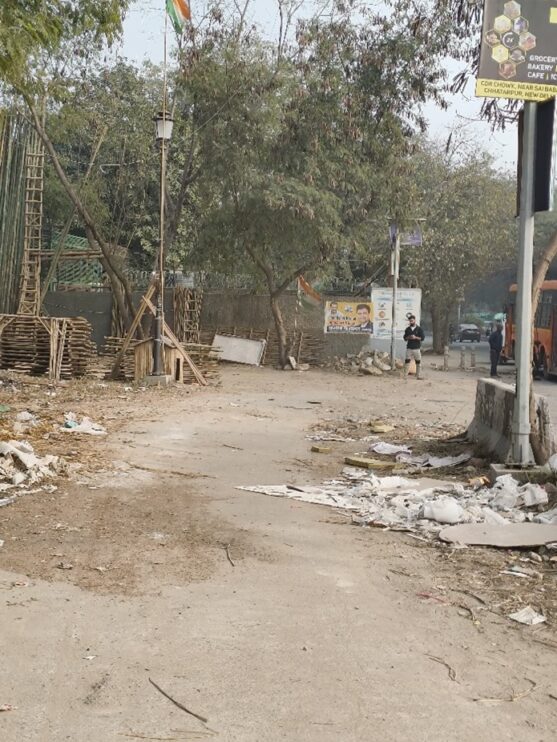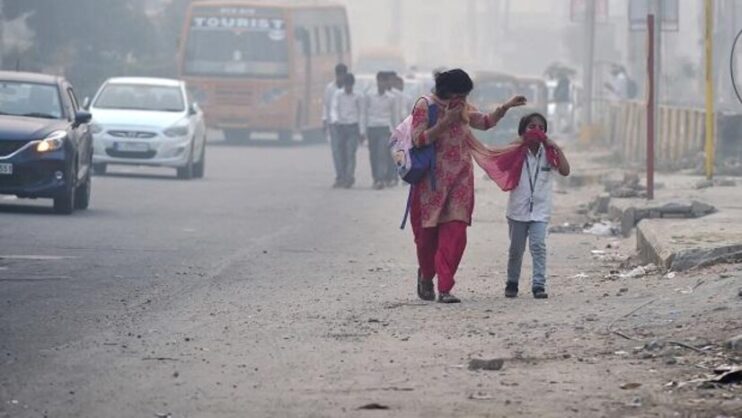By Nidhi Chaudhary
My interest in examining city space developed after reading Why Loiter?: Women and Risk on Mumbai Streets by Shilpa Phadke. The book is a feminist analysis of the public space and its occupancy by people of diverse identities. Conducting a meticulous examination of the changing landscape of Mumbai, the book compelled me to observe how different bodies occupy public space differently. An unwavering consciousness to observe the city also comes from being a woman where I constantly trade leisure and opportunities with safety.
I grew up in a neighbourhood called Yamuna Vihar in North East Delhi before moving to South Delhi in 2006. My parents moved to South Delhi hoping to give their children a better environment to grow up in. Apart from the cultural shock which included neighbours speaking in English and saying “hello” instead of the classic namaste, the infrastructural environment did not make much of a difference. In fact, over the years the city’s overall infrastructure has become less pedestrian-friendly. Playing local street games like oonch neecha ka paapda, chain chain, pithhu still holds a core childhood memory for me, something I would like my children to experience as well. However, new commercial laws and overconsumption have changed the landscape of Delhi over the years (Baviskar, Amita). There is no space to walk anymore let alone to play on the streets without the risk of being hit by a vehicle.

I recently visited jamna paar after nearly 20 years of leaving that place and I could not help but draw parallels between the current state of the neighbourhood and the one I remember from my childhood. I also drew infrastructural parallels between South and North East Delhi. The absence of women and girls from the streets and parks is something I could not overlook anymore. The park where I used to learn yoga and play badminton now only inhabits old and middle-aged men playing cards. Broken pavements and constant honking made it difficult to walk the few meters distance where I used to cycle once. As if now the city only belongs to the cars and the people driving them! I felt equally unsafe at both places (South and North Delhi) even though I knew the roads like the back of my hand.

In a recent talk by Reena Mahajan (an architect and an urban designer) at IIC[1], she highlighted how city planning has moved away from place-making to facilitating cars. She further added that this car-centric approach has turned cars into a cultural issue and a status symbol. Cars and other vehicles are majorly driven by men which further reduces the possibility of women and people with disability accessing the public space. A similar thought is advocated by Amita Baviskar in her book Uncivil City: Ecology, Equity and the Commons in Delhi where she comments on the changed landscape and social fabric of Delhi over the years which has resulted in the city accommodating cars more than human beings. The following quote from her book exhibits the lack of political will which has invisiblised pedestrians completely. “We walk in fear, huddling together for safety to cross the road, squeezing ourselves onto shrunken sidewalks, skipping out of the way as the next wave of menacing motors screeches past. And, instead of discouraging them, the government welcomes cars, strewing paths with wider roads, bigger parking lots, flyovers and underpasses, elevated roads and underground roads…”

Where do you walk? How do you walk? And most importantly why do you walk? Owing to their household responsibilities, women’s movement pattern differs from their male counterparts. Women travel frequent and shorter distances (Borker, Girija). Women also have limited access to capital and private vehicle which further impacts their confidence to drive leaving them dependent on public transport and walking (CIVITAS 2020). Walking as an important feminist activity, walking provides the opportunity to get out of the house without necessarily depending on others. It is an independent activity at the same time it is communal, it helps connect with our surroundings including people, nature, locality.
Additionally, in a conversation with Jaya Dhindaw from WRI, Lora Prabhu, co-founder of CEQUIN, talks about people’s right to public space irrespective of their gender. She further adds that how we interact with our environment shapes us as human beings. So, if we inherently believe that going out is dangerous for women then how are we expecting them to build leadership skills or access basics like education and health?
I recently visited Qutub Institutional Area and as I got out of the building in the evening, I stepped into pitch darkness as there were no streetlights. It was the lighting of the chai tapri (although only men were seated in that corner) which provided some sense of comfort while I located my auto. These small pockets of comfort are also the primal targets when the government decides to gentrify the city (Phadke, Shilpa). The gentrification drive with gated colonies, removing local shops from the streets has been commonplace since I was a child. I remember not being able to take my cycle to my friend’s house on another street because that involved lifting my cycle and crossing the colony gate. Suddenly, her house seemed far and inaccessible. The Lonely City by Olivia Laing is a deep dive into the expansive understanding of loneliness. Towards the end of the book, Laing connects gentrification with loneliness. She surveys that gentrification of a city (in her context it is New York) which comes from a place of oppression and privilege cannot bring genuine happiness as it kills the diversity of a city. The idea behind gentrification is to make the city more clean and “classy” but it further makes that city isolated and deserted.
It is not just the safety from sexual assault but safety from physical injury as well which will make the city liveable. Delhi is not entirely a bad city, there has been a commendable transition in the last 10–15 years with the metro reaching every part of Delhi and a new fleet of low-floor AC buses, and facilities such as Uber and Ola. However, this has further developed other challenges such as less space to walk even short distances and these challenges require attention. In the end, I would like to conclude with a quote from Rebecca Solnit from her book Wanderlust: A History of Walking which summarises how imperative walking is especially for women.
“For [Jane Austen and the readers of Pride and Prejudice], as for Mr. Darcy, [Elizabeth Bennett’s] solitary walks express the independence that literally takes the heroine out of the social sphere of the houses and their inhabitants, into a larger, lonelier world where she is free to think: walking articulates both physical and mental freedom.”
[1] The event was organised by the Institute of Urban Designers India (IUDI)
References:
- Solnit, Rebecca. Wanderlust: A History of Walking. New York: Penguin Books, 2000.
- Laing, Olivia. The Lonely City: Adventures in the Art of Being Alone. New York: Picador, 2016.
- Baviskar, Amita. Uncivil City: Ecology, Equity, and the Commons in Delhi. New Delhi: Oxford University Press, 2003.
- Phadke, Shilpa. Why Loiter?: Women and Risk on Mumbai Streets. New Delhi: Penguin Books India, 2013.
- Mahajan, Reena. “Redefining urban space, putting people first.” Lecture, Indian International Centre (IIC), organized by the Indian Urban Design Institute (IUDI), New Delhi, India, December 2024.
- Dhindaw, Jaya, and Lora Prabhu. “10 — Lora Prabhu: Sports as a Tool of Community Empowerment and Gender-Inclusive Cities” Youtube, uploaded by WRI, 28 October 2024. https://www.youtube.com/watch?v=oTNY0pgOYlY
- Borker, Girija. “Understanding the constraints to women’s use of urban public transport in developing countries☆” 2024. PDF file. Published by Elsevier. https://girijaborker.wordpress.com/wp-content/uploads/2024/07/borker_world_development.pdf.
- CIVITAS. 2020. “Gender Equality and Mobility: Mind the Gap!” Policy Note. CIVITAS WIKI Policy Analyses. Brussels: CIVITAS Initiative. https://civitas.eu/sites/default/files/civ_pol-an2_m_web.pdf.
About the Author: Nidhi is currently working with CREA as a consultant on gender and WASH programs with a specific focus on urban sanitation. She is a post graduate in Gender Studies and has been working on the issues of gender and sexuality for the last 5 years. She finds value in exploring and unpacking her surroundings through a feminist lens, including city space, nature and pop culture.
